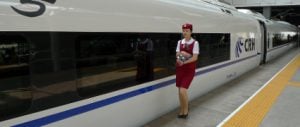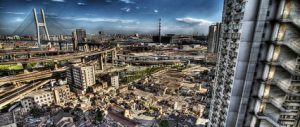An ambitious scheme to link all major American cities within 800 kilometres of one another by high-speed rail before the middle of the century is an achievable goal, according to the United States PIRG, a federation of state Public Interest Research Groups.
But bipartisan political co-operation is essential for building a sustainable transportation system that could ease road congestion, reduce air pollution and carbon emissions, and offer travellers in the United States more alternatives.
Support for high-speed rail is seen as crucial to president Barack Obama’s plans to revitalise the United States’ neglected infrastructure and to create jobs. His political opponents now sneer at “ObamaRail” and are eager to derail the administration’s US$53 billion (348 billion yuan) transportation scheme, even though widespread enthusiasm for these faster modern trains had been anticipated.
High-speed rail has come to mean more than getting from point A to point B – it is a new litmus-test issue that establishes political credibility. Proponents see a way to catch up with state-of-the-art mass transit in Europe and Asia and to cut travel costs for middle-class workers; sceptics tend to scorn high-speed rail enthusiasts for romanticising outmoded, overpriced conveyances that few car-owners or frequent flyers would bother to ride.
After his landmark environmental legislation failed to pass, Obama did not even mention climate change during his State of the Union speech in January 2011, but he proposed a new tactic to “win the future”. Obama called for slashing billions of dollars in subsidies to oil companies and ramping up mass transit.
“To attract new businesses to our shores, we need the fastest, most reliable ways to move people, goods and information – from high-speed rail to high-speed internet,” Obama said. “Within 25 years, our goal is to give 80% of Americans access to high-speed rail, which could allow you to go places in half the time it takes to travel by car. For some trips, it will be faster than flying – without the pat-down. As we speak, routes in California and the Midwest are already under way.”
Washington’s plans for intercity bullet trains are already getting shot down. By spurning the federal money on offer for public transportation, politicians with libertarian tendencies hope to shore up their Tea Party support. First term Republican governors in three states – Florida, Ohio and Wisconsin – recently turned down billions of dollars in high-speed rail subsidies, and also lost potential jobs linked to project construction and railway operation.
Fiscal prudence is the reason cited by these conservative politicians for rejecting the federal funds for high-speed rail corridors. Republican governors Rick Scott, John Kasich and Scott Walker justified their move by suggesting it would prevent their states’ taxpayers from getting stuck with financial commitments for maintaining the newfangled trains or covering the extra costs if these technologically advanced projects go over budget. A number of private corporations, said to include international firms Siemens and Alstom, had shown interest in assuming construction and operations risks in exchange for the right to operate the bullet trains in Florida, but governor Scott axed the project before it could morph into a “boondoggle”, and the Supreme Court ruled unanimously that he had the right to do so.
After transportation secretary Ray LaHood announced that other states looking to build high-speed train networks now would be eligible for these funds, 24 have applied. The Northeast Corridor, America’s busiest rail line, on which the country’s only existing quick trains run between Boston and Washington DC, is tipped to get more money.
Corrine Brown, a Democratic congresswoman who joined a national caucus (a political grouping) for high-speed rail, remarked that Florida’s refusal of US$2.4 billion (15.8 billion yuan) for a high-speed link between its cities of Orlando and Tampa makes her home state look “stuck on stupid”. The group is concerned about proposals to end federal funding for trains run by government-owned Amtrak and to cut funds for high-speed rail that were included in the first economic stimulus package.
Another Floridian lawmaker, chairman of the House of Representatives’ Committee on Transportation and Infrastructure John Mica, has urged private funding over federal expenditure. “Amtrak operates a Soviet-style passenger rail service, with a high rate of subsidisation by the taxpayers,” he said. “Last year, every single Amtrak ticket was underwritten by US$54.48 [358 yuan].”
Some US vested interests – such as regional airlines, or the gasoline industry – may be less than thrilled with the prospect of bullet trains thundering across America at speeds up to 400 kilometres per hour. But even the chairman of China Southern Airlines is impressed with high velocity ground transport, though he worries about its effect on his market shares because bullet trains compete on about 25% of his routes. “High-speed rail has three advantages over air travel,” Si Xianmin was quoted as saying in The Economist. “It is more convenient, more punctual and has a better safety record.”
Creating jobs for Americans is a priority in today’s economy, and libertarian critics worry that privately-owned fast train networks would be foreign-run. They contrast the cost of a mile of high-speed rail in China, roughly US$15 million, with the estimated US$40 million to US$80 million per mile to build it inside the United States. Such concerns did not trouble the original railway barons. Historically, Chinese labour was essential to the American transcontinental railroad. Ninety percent of the workers who blasted tunnels and laid ties over the High Sierras in the nineteenth century were Chinese.
Even though it has been hailed by prominent environmentalist activists as a way to beat highway traffic jams and curb pollution from short-stop air travel, high-speed rail has not yet captivated the imagination of car-loving Americans in sprawling suburbs. Samuel R Stanley, an urban-policy expert at the Reason Foundation, a non-profit group which promotes free market principals and advised governor Scott, explained why: “We question the wisdom of getting sidetracked into funnelling billions of dollars into a redundant technology that is likely to have a marginal impact. We have been down this road before,” he told chinadialogue.
“Costs must be highly subsidised and over intermediate distances, the private intercity bus lines already are proven. This strategy is bound to a vision that it is equivalent to our federal highway system, but the analogy doesn’t work. High-speed rail doesn’t offer a real improvement or a new class of service. What’s proposed in the United States is a redundant system. It actually is medium-speed rail. People in China would laugh at a top speed of 150 miles [241 kilometres] per hour. High-speed rail will serve a small segment of clients who need transit to large urbanised areas. Money can be better used for other transportation challenges – repairing bridges, local transport, roads. Why should the national priority be high-speed rail?”
In California, high-speed rail is already under way. Former governor Arnold Schwarzenegger was duly impressed by the speed of Chinese and Japanese passenger trains, and backed the California High Speed Rail Authority in late 2007. The first section, from Fresno to Bakersfield, has been ridiculed because it’s located in the sparsely-populated Central Valley, but this strategic section will eventually connect Los Angeles to San Francisco.
Environmental activists are anxious that high-speed rail in the United States be as “earth friendly” as possible, and have urged planners to commit to sustainable land-use and development patterns. A campaign website run by the Sierra Club, the country’s oldest grassroots environmental organisation, points out further green attributes:
* HSR (high-speed rail) requires one-sixth of the energy per seat-mile of equivalent airline travel and one-third of the energy of automobile travel.
* HSR “recycles” railroad beds that can easily be 100 to 150 years old and thus feature energy-conserving grades.
* HSR stations strongly encourage the redevelopment of pedestrian & transit-friendly office districts.
* Electric HSR draws energy from the national power grid that utilises otherwise impractical sources of “renewable” or domestic energy.
* Electric HSR transfers most pollution problems to large stationary power plants that offer the best chance for pollution control.
* Electric HSR can regenerate significant amounts of useful electric power as trains decelerate for curves and stations.
* Electric HSR locomotives and power distribution systems have remarkably long lives and low maintenance costs.
In contrast to the United Kingdom, where a campaign against a new high-speed rail link between London and Birmingham concentrates on noise levels, rural aesthetics and negative effects on residential property values, the objections in the United States are mainly ideological. Opponents of big government are openly hostile to high-speed rail.
Former British prime minister Margaret Thatcher abhorred rail projects that ran on public money, and famously cancelled the British tilt-train project because it wasn’t a private enterprise, but even today’s Conservative party backs high-speed rail. Writing in The Independent newspaper in February, UK transport secretary Philip Hammond said: “The evidence from abroad is that high-speed rail is the only effective sustainable answer to intercity transport challenges.” If the United States ignores an opportunity to reshape its economic geography with high-speed trains, it’s likely to get left behind.
Jan McGirk is a former correspondent for The Independent (London) who has reported on environmental issues and disasters in Asia, Latin America and the Middle East.
Homepage image from California High-Speed Rail Authority


